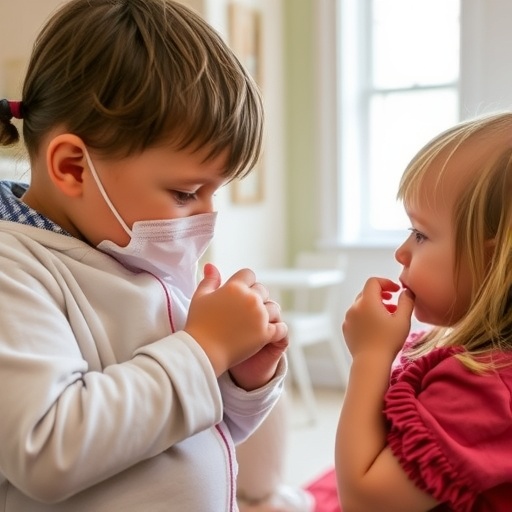In a groundbreaking study published in BioMedical Engineering OnLine, researchers have unveiled compelling evidence that meteorological factors play a crucial role in the hospitalization rates of children infected with respiratory syncytial virus (RSV). This virus, a predominant cause of severe lower respiratory tract infections in infants under one year of age, remains a persistent global health threat. The study, covering data from 2017 to 2023, meticulously analyzes seasonal trends and the influence of climatic variables in Tianjin, China, a region characterized by a semi-arid and semi-humid monsoon climate. The findings promise to reshape public health policies and strategies aimed at curbing RSV’s impact on vulnerable pediatric populations.
RSV infection seasonality has been observed worldwide, with fluctuations often linked to geographic and climatic conditions. However, understanding the direct meteorological associations with RSV hospitalizations has remained elusive in many parts of the world. This research fills a critical knowledge gap by employing advanced time series analysis methods to discern how environmental conditions modulate RSV infection rates among children. Using a robust cohort of 6222 hospitalized pediatric patients, the study correlates hospitalization data with detailed meteorological readings, including temperature, air pressure, wind speed, humidity, and precipitation obtained from Tianjin’s Binhai International Airport meteorological station.
The methodology employs a seasonal Autoregressive Integrated Moving Average (SARIMA) model and Generalized Additive Models (GAM), statistical frameworks celebrated for their efficiency in modeling complex, non-linear relationships in epidemiological time series data. The SARIMA (1,0,0)(0,1,2)12 model emerges as a particularly adept predictor of RSV hospitalization patterns, capturing both seasonal trends and underlying temporal autocorrelations. This predictive capability highlights the potential to forecast RSV hospitalization surges, enabling preemptive public health interventions.
One of the study’s pivotal findings is the significant negative association between average monthly temperature and RSV-related hospital admissions. Lower temperatures correlate strongly with increased hospitalizations, which aligns with global clinical observations linking colder weather to heightened RSV transmission. This inverse relationship underscores the importance of seasonal temperature fluctuations as drivers of viral epidemiology. The mechanistic underpinnings may involve temperature-dependent viral stability and host immune responses that intensify infection risk during colder months.
Beyond temperature, the research probes the impact of additional meteorological parameters but identifies temperature as the dominant factor influencing hospitalization rates. Air pressure, wind speed, and precipitation were evaluated, yet their associations with RSV hospitalizations did not reach statistical significance in this regional context. Humidity, often cited in respiratory virus transmission studies, showed indirect associations and requires further exploration to elucidate its precise effect on RSV dynamics in Tianjin’s unique climatic environment.
The integration of SARIMA and GAM models presents a powerful analytical approach to navigating the multifactorial drivers of infectious disease seasonality. By fitting the SARIMA model to longitudinal hospitalization data and subsequently applying GAM analysis, the study deciphers not only aggregate seasonal trends but also the nuanced, potentially non-linear impacts of meteorological variables. This dual-model strategy significantly advances our capacity to model and predict infectious disease outbreaks with high temporal resolution.
Perhaps most critically, these findings bear significant implications for public health infrastructure and policy-making. Accurate forecasting of RSV hospitalization peaks through sophisticated models enables optimal allocation of medical resources, including hospital beds, ventilators, and specialized staff. It also facilitates the strategic timing of preventive measures such as enhanced hygiene campaigns and targeted prophylactic therapies for high-risk infants, particularly during colder months when the burden peaks.
In addition to optimizing healthcare delivery, the study provides vital insights that could accelerate the development and deployment of vaccines and therapeutic agents. Understanding the meteorological forcings that modulate RSV transmission can refine epidemiological models used in vaccine efficacy trials and improve the timing of therapeutic interventions. Such approaches could markedly reduce RSV-associated morbidity and mortality worldwide.
The research further highlights the necessity for region-specific studies in infectious disease epidemiology. Climatic conditions vary dramatically across different global zones, and the nuanced environmental impacts on RSV observed in Tianjin may differ from those in tropical or temperate climates. As a result, localized meteorological surveillance integrated with epidemiological monitoring emerges as a best practice for managing RSV and potentially other seasonal respiratory viruses.
This study also opens new avenues for interdisciplinary collaboration, integrating meteorology, epidemiology, and bioengineering. The refined statistical models used here demonstrate the potential for engineering innovation to revolutionize infectious disease forecasting. Investment in sensor technology and data analytics could catalyze real-time, high-fidelity monitoring systems, enabling rapid responses to emerging infectious threats.
While the findings underscore temperature’s pivotal role, the authors acknowledge the complexity of RSV pathogenesis and transmission. Factors such as viral genetics, human behavior, indoor air quality, and socio-economic conditions interplay with meteorological variables to shape infection dynamics. Future research scopes include integrating such multifaceted determinants into even more comprehensive predictive models.
Ultimately, this study’s innovative use of SARIMA and GAM models to link local meteorological data with pediatric RSV hospitalizations establishes a new paradigm in infectious disease forecasting. It lays the groundwork for proactive, data-driven public health strategies tailored to environmental cues. With RSV continuing to challenge healthcare systems globally, such scientific advances are both timely and transformative.
To summarize, the detailed temporal analysis from Tianjin reveals that colder months with lower average temperatures correspond to elevated RSV hospitalization rates in children under one year old. By harnessing sophisticated time series analytical methods, this research not only improves our understanding of RSV seasonality but also enhances predictive modeling to inform prevention and treatment efforts. It is a testament to the power of integrating environmental science and epidemiology in addressing critical pediatric health challenges.
As RSV continues to evoke concern worldwide, especially for infants who lack mature immune defenses, studies such as this are invaluable. Their implications ripple beyond academia into the realms of public health policy, clinical preparedness, and biomedical innovation. With climate change potentially altering local meteorological patterns globally, understanding these environmental influences on infectious diseases like RSV is imperative for safeguarding future generations.
Subject of Research: Relationship between meteorological factors and RSV-related hospitalizations in children.
Article Title: Relationship between RSV-hospitalized children and meteorological factors: a time series analysis from 2017 to 2023.
Article References:
Wang, S., Wang, Y., Zou, Y. et al. Relationship between RSV-hospitalized children and meteorological factors: a time series analysis from 2017 to 2023. BioMed Eng OnLine 24, 10 (2025). https://doi.org/10.1186/s12938-025-01339-y
Image Credits: Scienmag.com
DOI: https://doi.org/10.1186/s12938-025-01339-y
Tags: advanced time series analysis in health researchenvironmental conditions and RSV ratesglobal health threats from RSVhospital data and climate correlationimpact of climate on respiratory infectionsmeteorological factors and child healthpediatric respiratory syncytial virus researchpublic health strategies for RSV preventionrespiratory infections in infantsRSV hospitalizations and weather patternsseasonal trends of RSV infectionTianjin China RSV study





